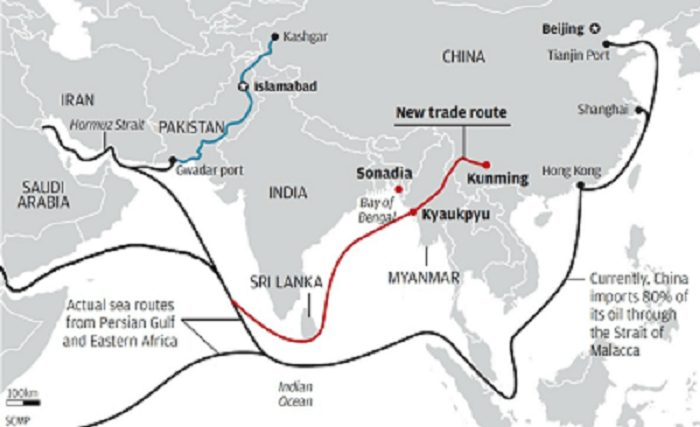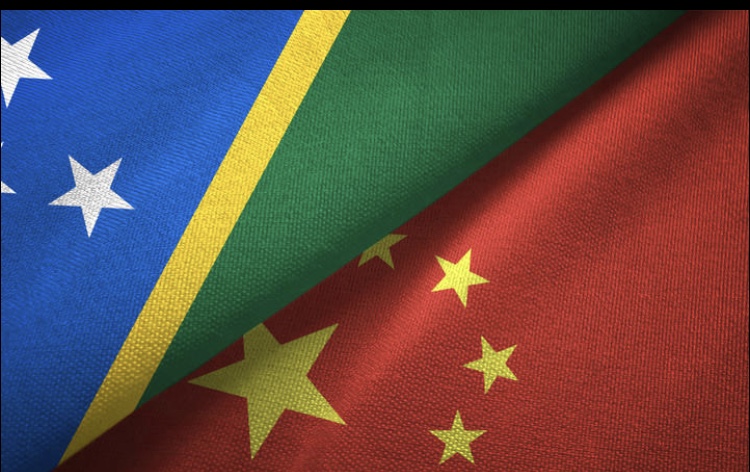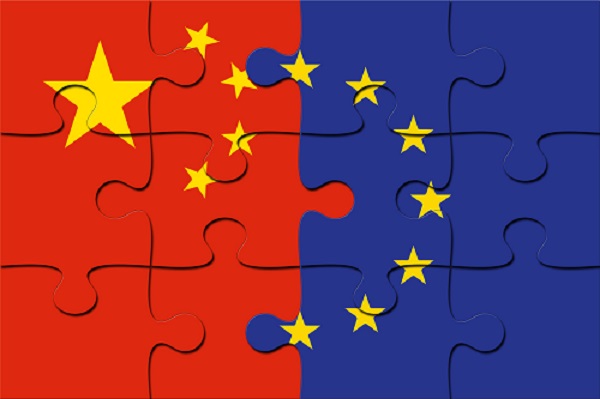Mohd. Adnan, Research Intern, ICS
Contemporary
Sino-Japanese relations rested on the logic of economic competition and
interdependence along with prevalent distrusts and territorial disputes, have
become one of the most crucial bilateral relations in the world. Despite
competing with each other over various overlapping economic and strategic
interests, their increasing bilateral trade have inextricably bound to each
other. World’s second and third largest economy China and Japan respectively,
at one side, entangled in regional competition to gain influence and their confrontations
over disputed
Senkaku (Diaoyu) Islands situated in East China sea.
On the other side, their indispensable economic interdependence has been the
key aspect of their complex relationships. In 2012, the relations between them
were severely strained over the confrontations on Senkaku islands. However, increasing
economic interdependence and United States’ inward looking “America First”
approach have provided an impetus for both states to pacify their relations. This
paper intends to explore the contemporary dynamics of Sino-Japanese bilateral
relationship.
Historically,
Sino-Japanese relations have been of a competitive nature rather than mutual
collaboration. Japanese aggression during the late nineteenth and first half of
twentieth century has left a deep impact on contemporary Sino-Japanese relations.
The relations between them got normalized in the beginning of 1970s and
subsequently, they have signed the Treaty of Peace and Friendship in 1978.
Japan has invested heavily in and provided much needed essential technologies
to China for its development in the post-Mao era. As Kerry Brown in his 2016 article
in The Diplomat, explained,
without Japan’s assistance in form of ‘technology and knowledge’, China’s
opening up and reforms would not have succeeded ‘as quickly and extensively’ as
it happened.
The
end of the Cold War and relative rise of China created an environment of
competition between these two giants. In 2012, the relations between them hit
a serious blow when Japanese government
purchased three out of five Senkaku islands from their private owners in order to
fully legitimize its claim over the disputed islands. China vehemently opposed
this act and various anti-Japan protests erupted across mainland China.
Japanese products were boycotted by public and relations between them were
severely damaged.
The
impasse between China and Japan remained intact until a surge of populism was
witnessed in 2016 US presidential election. Consequently, the United States
partially relinquished its previous neoliberal approach of leading free trade
and open market and opted for an increasingly inward looking “America First”
approach. This so called “America First” approach allows the US administration to
renegotiate trade deals with its major trading partners and its adoption of
protectionist approach to pressurise these partners by putting tariffs. This
new development in the international market has unintentionally pushed China
and Japan to step aside their differences and come to a cooperative platform.
Amid US-China trade confrontation and its protectionist approach, first,
Chinese Premier Li Keqiang visited Tokyo and a subsequent reciprocal visit by
Japanese Prime Minister Shinjo Abe was witnessed in 2018. Since then both
states maintained their complicated relationships despite competing and
confronting with each other in many overlapping economic and strategic interests.
Contemporary
Sino-Japanese economic relations revolve around two sets of notion. On the one
hand, they are increasingly interdependent owing to the huge amounts of
bilateral trade. According to the data
provided by Japan’s foreign ministry in
fiscal year 2019, China is by far the largest trading partner of Japan and
bilateral trade between them well exceeds above US $ 300 billion. Further, China’s
vast demography and rising middle class provides a lucrative market to
export-led Japanese economy. While, witnessing the increasing rift between the
United States and China, Japan’s importance to China has grown in many ways.
Japan has been the major source of essential technology for China since its
‘opening up’ in late 1970s. At a time, when the US is barring
Chinese companies from acquiring essential technology, China’s reliance on
Japanese technology will only increase. Moreover, while the US is retaliating
against its major trade partners including China and Japan, increasing economic
engagement becomes a necessity for both states to reduce their dependence on the
US markets.
The
economic interdependence between China and Japan is expected to further
increase once the Regional Economic Comprehensive Partnership (RCEP) is signed.
RCEP
is a trade agreement, which emphasises on reducing tariffs, between the ten
member countries of Association of Southeast Asian Nations (ASEAN), China,
Japan, India, South Korea, Australia, and New Zealand. Last year in November,
these states signed text-based negotiations, in which India opted to exclude
itself. However, a fissure
has surfaced in RCEP because Japan seems reluctant to sign the deal without the
inclusion of India. Japan fears without the involvement of India, RCEP will be
dominated by China. Though, China is coaxing both Japan and India to get back
in the fold of RCEP. It is expected that the Pact will be signed in the year
2020. According to a report
published in Xinhua on 5 November, 2019, “once
(RCEP) signed, it will form the largest free-trade agreement in Asia covering
47.4 percent of the world’s population, and accounting for 32.2 percent of
global GDP, 29.1 percent of trade worldwide and 32.5 percent of global
investment”.
On
the other hand, since both states are largely export-led economy, they have
been competing with each other in third party markets. China and Japan, in
recent years, increasingly competed
with each other in third party markets on trade, infrastructure projects, and
investments, particularly in Southeast Asian countries. Such is the competition
that Japan initially avoided to become part of China’s Belt and Road initiative
(BRI) – a land-based and maritime infrastructure projects aimed to enhance
China’s influence in and connectivity with the rest of Asia, Europe and Africa.
And in 2015, Japan initiated its own policy known as ‘Partnership
for Quality Infrastructure’ aimed to rival
BRI through developing infrastructure projects in foreign countries.
However,
in 2017, Japan agreed to cooperate with BRI under certain conditions. A year
later, on June 26, 2018, during the Japanese Prime Minister’s visit to Beijing,
the first ‘Third-Party Market Cooperation Forum’ was organised in which both
states agreed
to participate in conducting joint
venture projects in third-party markets. According to a report
published on the website of the State Council
of China on 26 October, 2018, ‘At the (aforementioned) forum, more than 50
cooperation agreements were reached between local governments, financial
institutions, and enterprises from the two sides, with the total amount
exceeding $ 18 billion’. But conducting such projects is fraught with difficulties,
given the competitive nature of this agreement and conditions placed by
Japanese government on its enterprises while venturing on third-party projects
with China. Further Japan’s insistence on quality and financial viability of
targeted projects contrasts with China’s ignorance of these elements. For
example, in 2018, a high
speed rail project in Thailand was planned
to be conducted by the companies from China and Japan but Japanese company
abandon this project due to the financial risks involved.
From
the strategic point of view, there has been a deep distrust and clash of
interests between China and Japan. China’s growing assertiveness in East and
South China seas and its claim over Senkaku (Diaoyu) islands and South China
Sea increasingly discomforts Tokyo. Further, China’s insistence to ignore
International Laws such as Permanent Courts
of Arbitration’s July 2016 decisions nullifying its claims in South China Sea
contrasts the principles and interests of Japan. To counter Chinese interests
and claims, in 2015, Japan introduced the vague concept of ‘Free and Open
Indo-Pacific’. Vague in the sense, it does not have a coherent policy and over
the years various elements have been added and removed. As the name indicates, it
promulgates for an open and free Indian and Pacific Ocean contrasts to China’s
claim over South China Sea and its growing influence in Indo-Pacific Ocean.
Apart from that, this vague policy also emphasises over freedom of navigation
and acceptance of international norms and laws.Through propagation of ‘Free and
Open Indo-Pacific’ approach, Japan seeks to mould China in the Western-led
International Laws and Treaties, and at the same time, Japan also wants to
constrain China’s assertiveness in the region detrimental to its interests.
Further,
China’s growing military power and its assertive nature in the region creates a
sense of insecurity in Japan. It is a common notion in Japan along with other regional
states that China seeks dominance and hegemony in Asian continent. To counter
it, Japan propagates a multi-polar order in Asia and adopted a policy of
building alliances with like-minded countries, which share the same views and
are worried with China’s relative rise. Japan has historical military
alliance with the US since the end of Second
World War. Recently these two states along with Australia and India have
revived the Quadrilateral
Security Dialogue initiative, which
earlier, in 2007, came into existence but faded away amid China’s opposition. Quad
initiative similar to ‘Free and Open Indo-Pacific’ policy but differ in the
sense that it has four member state seeking to counter-check China’s growing
influence in the Asia-Pacific region.
Along
with the territorial dispute, Japan’s close association with the United States
and its opposition to Chinese assertiveness in the region have been contrary to
China’s interests. It is widely held belief in China that through the revival
of Quadrilateral strategic alliance, the US is trying to contain Chinese
influence in the region. Japan’s participation in this alliance is perceived by
China as a step to limit its growing influence in the region and taking side in
a broader Sino-US rivalry. In other words, China sees itself as a major power
capable of dominating Asian Continent and feasible challenger to the US led World
Order. It expects from Japan along with other regional actors to conform to its
interests and do not take side with the US in the broader Sino-US rivalry.
The
relations between China and Japan are one of the most complex bilateral
relations in the world. Despite competing and clashing with each other in
myriad of overlapping interests and prevalent distrust, their economy is well
integrated and bilateral trade have continuously been increasing. Their bilateral relations, which were severed
in 2012 over Japan’s nationalization of Senkaku (Diaoyu) islands, have been
steaming up again owing to relative decline of the US in the region and it’s
America First’ approach. Both states have been continuously propagating for
increasing engagement and cooperation. However, structural and political
differences between China and Japan remained intact as they were three years
ago before their rapprochement.


